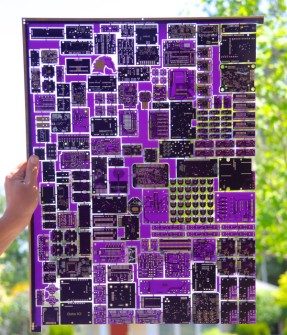
Excited about the new board design?
Great! So are we!
Check your Design Rules and Specs
Part of any great design is making sure that what you’ll get matches what you designed.
- The design rules, stackup, and specifications depend on your chosen fabrication service. You’ll want to enter the important information into your design tool’s DRC checker so it can verify things for you.
- Run your DRC tool. We don’t perform any design rule checking on our end, since your design tool will help you fix errors more efficiently than we can.
- EAGLE users can load our design rules files, which contains all the DRC information.
Preparing the design for fabrication
- Preparing the board outline: We use a separate board outline file that tells us where your board edge should be. We use that for both calculating the board size and cost, and send it to the fab for a milling guide. Most design tools have a special layer for this. You can also use Gerbv to get one from a different layer.
- If you have any internal cutouts or slots, you’ll want to verify that your design tool generates them how we expect.
- Preparing a bitmap or logo: As much as we love board art, some ways of generating it can be problematic. We can handle silkscreen logos up to 500 DPI but the process can be a little complicated. With a few adjustments though, you can ensure your design comes through as expected.
- Check connections against your schematic.
- Check footprints against the datasheet.
- Make up your bill of materials and verify all your parts are in stock. Nothing is worse than ordering a board, only to realize a critical component isn’t for sale.
- Add a time stamp, version number, the board name, and any other extra text you want.
- In Eagle, run
ratsnestone more time to make sure any airwires and ground planes are cleaned up. - In other design tools, you may need to rebuild ground planes, fill zones, or other final steps to ensure your copper pours connect properly.
- Run the Design Rules Check (DRC) to verify your design against our fabrication specs.
- EAGLE users can grab our handy OSHPark DRU file right away.
- Do a last-minute once over on your design, and look for odd spots. Are all the traces routed? Will a via or pad mess up your silk? Is everything you care about inside the board outline? Are there any dead-end traces? If so, correct them and re-run the DRC.
Preparing the manufacturing files for submission
- It’s often a good idea to take a look at our Design Tool Help section. We try our best to keep track of surprises that might affect fabrication, to save you some trouble.
- Run the DRC checker one more time. You can’t use this tool too often!
- EAGLE users can usually upload the .BRD file directly to oshpark.com, and let us make the gerbers. In some cases though, you may want to generate your own gerbers.
- Generate the gerbers: Our Design Tool Help has tips for generating gerbers from design tools. Our automatic upload process expects the following layers for a typical PCB:
- Board Outline
- Top Copper
- Bottom Copper
- Top Mask
- Bottom Mask
- Top Silk (Optional)
- Bottom Silk (Optional)
- Internal Layer 1 (4 Layer only)
- Internal Layer 2 (4 Layer only)
- Preparing the drills file: There’s a lot of odd drill formats, so this tends to be the most problematic file. Our Design Tool Help section will have specific tips for your tool, but generally the format we need is
- NC Drill Format (sometimes labeled Excellon)
- Inches
- 2:4 precision
- Absolute Coordinate Origin
- No Zero Suppression or Leading Zero Suppression
- Verify the gerbers using a compatible gerber viewer program, such as gerbv.
- If you have a 4 layer board, convert all the internal layers to positive layers.
- Remove Alignment points: Ultiboard tends to add alignment points on the files, which confuses our site’s pricing system. Removing those is suggested.
- Supported Naming Pattern: Our site can detect the default gerber layer naming schemes from several PCB design tools, but this is a naming scheme that is known to work. This is especially important for 4 layer designs to ensure that the internal planes are where you expect them.
- Finally, upload the gerbers in a .zip file to oshpark.com.
If you get through all these steps and are still having trouble, or just have questions, feel free to contact [email protected].
